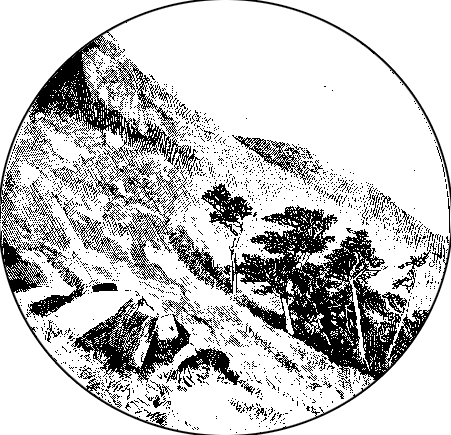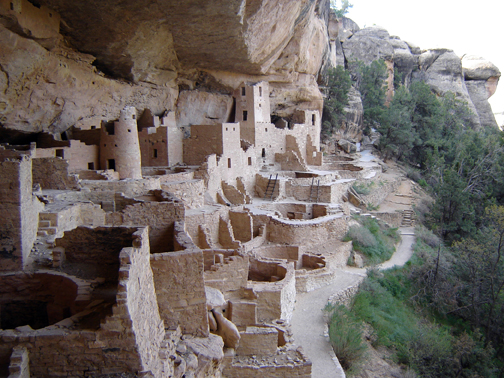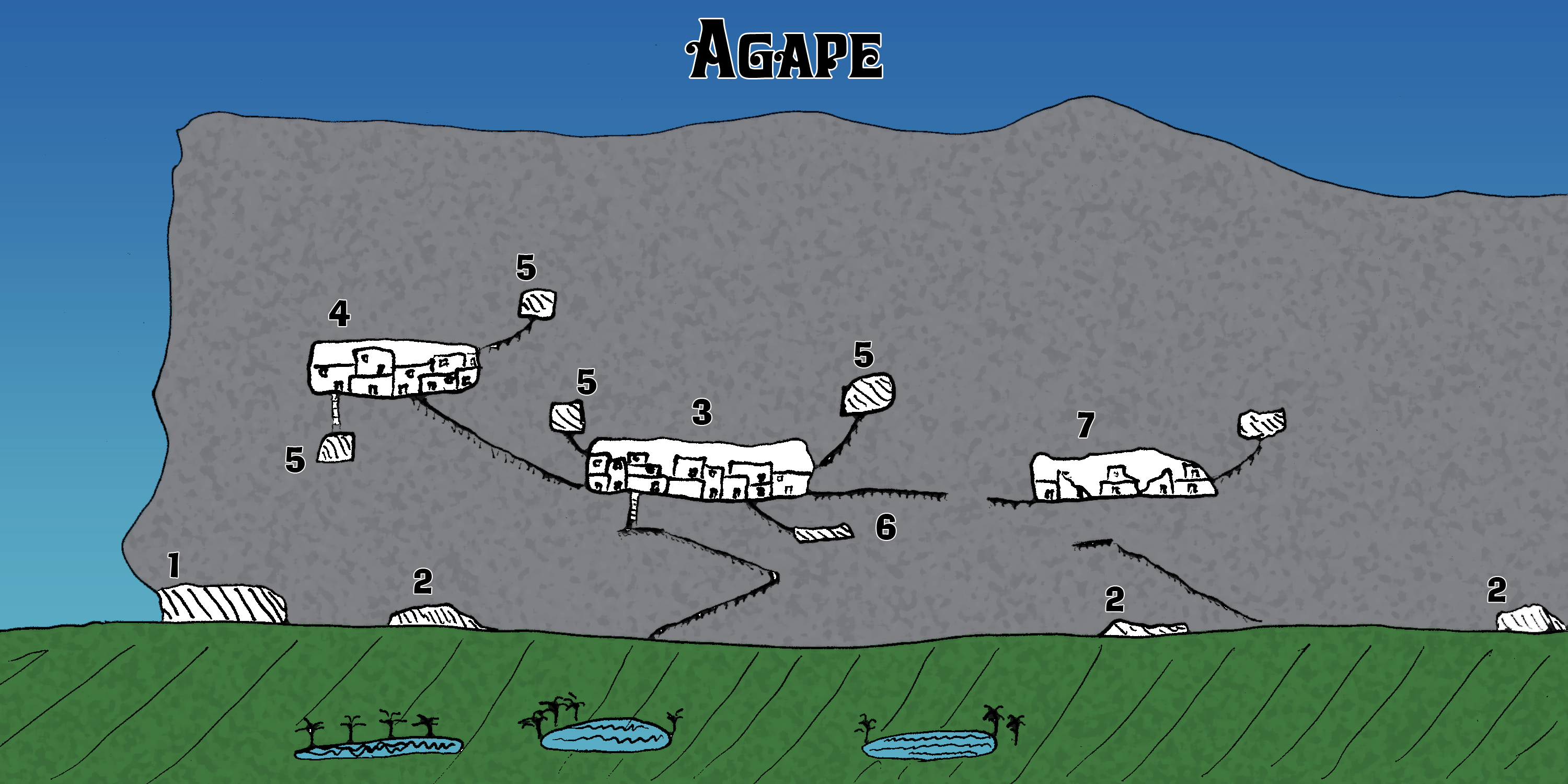
Andrew Larsen
The Region
 The area around Agape is characterized by a number of small waterholes, most of which are fed from streams running down the wall of the mesa, although a few well up from the ground. By Praxian standards, the area is quite lush, with numerous acacia trees, date palms, stands of flowering shrubs, and ample grasses. Papyrus grows along the edges of the waterholes. Watermelons and serpentweed are easily found. During Storm and Sea season, there is often a thin morning mist that hangs around until the rising sun burns it off.
The area around Agape is characterized by a number of small waterholes, most of which are fed from streams running down the wall of the mesa, although a few well up from the ground. By Praxian standards, the area is quite lush, with numerous acacia trees, date palms, stands of flowering shrubs, and ample grasses. Papyrus grows along the edges of the waterholes. Watermelons and serpentweed are easily found. During Storm and Sea season, there is often a thin morning mist that hangs around until the rising sun burns it off. Because of the waterholes, wildlife is quite common in the area. The ponds themselves are constantly host to a range of Praxian birds and animals, particularly substantial numbers of Praxian cranes, but also ducks, spoonbills, grebes, cowpeckers, hawks, marmots, wild ui, lizards, wild goats, and of course Eiritha beasts. Snakes are very common here, including rhinoceros snakes, but few of the snakes are poisonous. Predators such as lions, feral dogs, hyenas, and even occasional daggertooth cats and leaping bears are found in the region, drawn by the ample prey. Basmoli and Agimori frequent the area as well, because of the good hunting.
The Pueblos
About a hundred feet above the ponds, the largest of the caves is the site of a substantial pueblo. The cave has a long, high mouth but is comparatively shallow. Houses built out of mesa stone and mud brick are packed tightly against another, with enough housing to hold several hundred Oasis Folk; some of these buildings are accessed through doors in the front wall, while others are entered through the roof, via a ladder. A second, slightly smaller pueblo lies a short ways to the west of the main pueblo, accessible by a narrow path carved into the face of the mesa centuries ago. Both of these pueblos have a network of cisterns designed to catch the condensed vapors and store their water for the use of the Oasis Folk. The Oasis Folk have also carved out a series of storage chambers in the face of the mesa where water vapors do not naturally exude, allowing them to keep grain and produce in relatively dry conditions.

The Oasis Folk engage in some formal agriculture, tending small fields of holygrain and skullbushes down by the ponds. They also cultivate the watermelons that grow easily, with a few small caves given over to melon vines. Other caves up along the mesa house pens of ui, the Praxian guinea pig. The Oasis Folk also hunt the birds and small beasts that come to the watering holes. They weave baskets, mats, and other items from palm leaves and papyrus, and make pots from the local clay; they often trade their produce and baskets to the Praxians; wool cloth and animal hides are common purchases.
In general, the Oasis Folk are remarkably good climbers, with little fear of heights. They are not, however, particularly bold; they avoid combat unless their pueblos are directly threatened. When dealing with outsiders, most Oasis Folk are polite and agreeably submissive, seeking to avoid saying anything that might contradict or displease those they are talking to; they will frequently agree to a suggestion and then simply ignore it as soon as practical. This can make interactions with them rather aggravating, and the nomads generally consider them all liars.
The Oasis Folk worship a goddess named Manali, who is a spirit of agriculture. Like most Oasis cults, it is a small cult with no importance beyond Agape. Unlike most Oasis cults, Manali is not a water spirit, but rather a plant spirit (her runes are Plant and Stasis) and is not considered a child of Camenura; the water at Agape is considered the gift of Eiritha. Manali is considered a friend of Eiritha, and is said to be a refugee from Genert’s Garden. The cult offers a variety of agricultural skills and two Divine Magic spells: Bless Crops and Preserve Food.
This spell must be cast on a food container. It preserves all organic matter within the container, protecting it from decay, mold, and small pests. Water will not leak into the container, nor will heat or cold affect the contents. The spell lasts for 1 season or until the container is opened, whichever comes first. It has no effect on living creatures, so it cannot be used to preserve someone’s life. 1 point of the spell will affect one small container, such as a pot or a bag. 2 points will affect one large container, such as a barrel or chest, while 3 points affects a very large container, such as a silo or a sealed room.
Manali’s priest, Salu, is the leader of the Oasis Folk at Agape. He is a deeply conservative man, convinced that his people’s well-being is best served by following traditional ways. He insists on keeping strangers out of the pueblos under all circumstances. He is not unsympathetic to strangers in need, but sees strict limits to what help he can safely give them. He is on good grounds with Chabi Jumping-Pot, and recognizes that the cult of Eiritha is a source of valuable aid. As a result, he will do almost anything to keep the good favor of the priestess of the Eiritha shrine. The pueblo routinely gifts her with baskets of food.
The other major figure among the Oasis Folk is Old Jaru, who is in his 50s. He is the most experienced hunter at the Oasis, and extremely knowledgeable about the mesa and the area around it. Although he does not worship Foundchild, he gets along with Praxian hunters quite well; he respects them, understands their concerns, and knows how deal with them. Unlike most of the Oasis Folk, he is not afraid to be disagreeable; he is honest, often to the point of bluntness, but also rather taciturn. He is the person most likely to tell outsiders important information.
The Old Village
The Oasis Folk currently occupy two pueblos, but there is a third, ruined pueblo, slightly to the east of the other two. The Oasis Folk call this the Old Village, and they do not go to it anymore. There is a trail that leads up to a platform about 15 feet below the Old Village, but there is no ladder to close the remaining distance; getting up to the Old Village requires two Climbing rolls. A narrow path in the face of the mesa leads from the main village to the Old Village, but at some point in the past, about 10 feet of that path has been cut away, leaving a sharp drop of about 200 feet to the ground; bridging the gap requires a Jumping roll at -20%.If questioned, the Oasis Folk say that the Old Village is haunted and that it is not safe to go there; they are reluctant to even discuss what happened to the Old Village. During the Sacred Time, the Old Village sometimes appears to be intact and occupied by men and women; it is, in fact, a Ghost Place.
The Eiritha Shrine
The northernmost cave at Agape is a fairly large cave at ground level, curtained off from the outside with animal hides. It is known as Eiritha’s Snout. Praxians claim that this cave is Eiritha’s mouth, and as such it is the second-most sacred place for the cult of Eiritha, after the Paps. The Snout is a permanent shrine to Eiritha, with a small staff of Eirithans who reside here permanently. The cave has powerful healing properties, and Praxians with unusual medical problems sometimes journey to Agape to seek healing at the Snout.The Snout is a woman’s shrine. It is forbidden for men or male animals to enter the Snout under normal circumstances. Men who seek assistance at the shrine are normally kept outside the cave and will be inspected and treated in the open air. On the rare occasions that men are allowed inside (which usually happens with difficult medical problems), it is under the fiction that they are actually women; they must be wrapped in a woman’s blanket and given a woman’s name for the duration of their visit.
When the light of the rising sun hits the shrine, the cool moist caves emit a low, haunting moan that is known as the Lowing. In the Dawn Age, Eiritha frequently issued prophecies to the priestesses of the Snout, but these stopped long ago. Why Eiritha has chosen not to speak is a source of discussion. Every priestess now hopes that she will become the first to receive a prophecy, but these hopes have been met with stubborn silence.
The Snout is also home to the Eirithan subcult of Sariba Walks-at-Dawn, a Dawn Age Eirithan. While most clans claim her as their own, evidence suggests that she was probably born into the Bison nation. She was married to a powerful Storm Bull khan, Chatokeh Walks-in-the-Wind, whose frenzies she learned to master. Her cult became so useful that it spread from her original nation and can now be found among all Praxian nations. After he was slain, she sought solace at Eiritha’s Snout, where she founded the shrine. Eventually she traveled down into Eiritha and never returned.
Any Eiritha woman can join Sariba’s subcult by sacrificing 1 point of POW and receiving a special tattoo. Her worshippers may marry, but may not remarry after their husband’s death. Once initiated, she must sacrifice 2 MPs to Sariba every holy day. Sariba teaches the Spirit Magic spell Calm Frenzy.
This spell calms the target, bringing it out of any frenzied or terrified state. The caster must overcome the target’s current mps. If successful, the target calms down. This spell cancels the effects of Fanaticism and Demoralize, brings a warrior out of Berserk frenzy, and calms a stampeding animal.
Other than the Oasis Folk of the pueblos and the Eirithans at the Snout, most of those at Agape are Praxians, particularly those who roam the South Head Acres. Trade caravans occasionally come through, on a journey between Cam’s Well and the Zola Fel, but there is much less of this sort of thing than at some oases (such as Day’s Rest or Moonbroth, which lie on more obvious trade routes). Thus non-Praxian visitors are somewhat unusual and are likely to arouse some interest, especially if they have goods to trade. Small bands of Agimori and Basmoli also roam the region, which tends to discourage smaller caravans from coming through. It is rumored that the Basmoli may have a shrine in a cave at one of the other mesas in the region.
The Thed Shrine
Agape has always been troubled by broo. According to legends, one of the caves along the mesa was the lair of Thed. However, there is some uncertainly about which cave is the one in question, and broo have been known to congregate at several of the smaller caves in the region. The Oasis Folk tell a number of ominous tales of those who went exploring those caves and never returned (or worse, returned pregnant with a broo), and so they do not go into those caves, although they will gladly point them out to eager chaos-hunters. Feral broo easily proliferate due to the ample numbers of wild animals in the region. Much less commonly, a more sophisticated group of broo takes residence in one of the caves; such bands have typically been destroyed by Storm Bulls from whichever clan is currently resident at Agape.Unknown to the Praxians and pueblo folk, there is another shrine at Agape, this one sacred to Thed. It marks the place where Thed hid after her rape, and it is there she grew strong and malevolent.
The Thed Shrine is hidden deep in one of the caves in the area, far on the east end of the mesa. It is the reason that this area has so much trouble with the broo. Feral broo instinctively migrate toward the shrine, and young broo grow much faster than normal, and tend to be more impressive specimens of that race. Additionally, the broo reproduce much more easily here; any creature they molest is almost guaranteed to become pregnant. Over the centuries, the shrine has been found and cleared several times, but those who did so never recognized it as a shrine and simply assumed it was another cave. Consequently, despite the attentions of the Storm Bulls in this area, the shrine remains an unnoticed threat.
The Map

1 The Eiritha Shrine, known as the Snout
2 These are small caves along the base of the mesa. They are sometimes inhabited by temporary visitors, caravans, and the like.
3 The Main Pueblo. Directly beneath it is the access trail.
4 The Small Pueblo. It is only accessible via the Main Pueblo
5 Storage caves. These caves hold grain silos and plots of watermelons.
6 The ui cave. The Oasis Folk maintain pens of ui here.
7 The Old Village. It is an uninhabited ruin. There is an access trail below it, and a partly destroyed trail that used to connect it to the Main Pueblo.
Scenario Ideas
Into Eiritha’s Mouth
The PCs are Praxians, traveling in southern Prax. One of them (or an important NPC) contracts an illness that resists normal attempts to cure it. A shaman attempts a spirit healing but is unable to overcome the disease spirit; he advises them to take the sick character to Eiritha’s Snout and seek healing there. Chabi agrees to take the players down Eiritha’s throat, where they will undergo a variety of challenges to persuade Eiritha to heal their sick comrade. And if they return, Chabi has a service they must perform for her…
Counting Heads
The PCs are Lunars, or Lunar sympathizers. A member of Governor Sor-Eel’s staff asks them to conduct a census of Agape. Chabi reluctantly agrees, but Salu steadfastly refuses to permit them to enter the pueblo to count heads. Salu has no understanding of the Lunar Empire’s size and power, and imagines the PCs are merely bandits trying to cheat the Oasis Folk somehow. Do the players decide to punish his intransigence by telling their superior that the Oasis Folk are in rebellion, or do they seek some other solution to the problem?
Seeing Ghosts
The PCs are at Agape during the Sacred Time, a time when the spirits of the dead manifest easily. An important NPC starts acting strangely. A Praxian tells them that the character is suffering from kubu, possession by the dead. The possessed character tells them that he is Arkalu, one of the restless spirits of the Old Village. He demands that they help him avenge an ancient wrong, and claims that the Old Village was massacred by the ancestors of the Oasis Folk during a quarrel between the pueblos. Is he telling the truth, or does he have a reason to wish to hurt the Oasis Folk? And will they agree to help him, or can they persuade a shaman to help exorcise the spirit?





